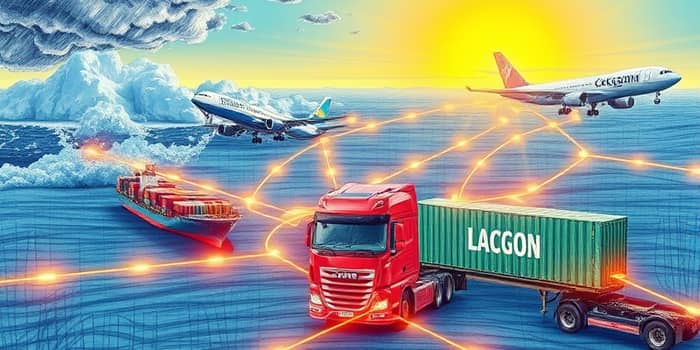
Supply chain disruptions have evolved from rare crises into ongoing, not isolated issues that challenge logistics providers and shippers worldwide. As tariffs, extreme weather, and regulatory changes collide, companies must rethink long-held assumptions and adopt new strategies to maintain smooth operations and customer trust.
Recent surveys reveal the scale and frequency of interruptions. Organizations now face an estimated $184 billion in annual costs due to delayed shipments, labor stoppages, and equipment shortages. In Europe, 76% of shippers encountered at least one major disruption in the last year, while 22% suffered more than twenty separate incidents. With these figures climbing, resilience is no longer a luxury but a core requirement.
To illustrate how varied these challenges are, consider the primary sources identified in a 2025 industry poll:
Geopolitical tensions, from Russia-Ukraine conflicts to Middle East instability, continue to disrupt trade corridors. Meanwhile, climate change triggers extreme weather events—flooded ports, damaged infrastructure, and rerouted shipments. Cyberattacks and fraud introduce another layer of uncertainty as hackers target logistics platforms and sensitive cargo data. Regulatory scrutiny, particularly in the European Union, demands stricter compliance and transparency, adding complexity to cross-border operations.
Globalization, while boosting overall efficiency, has also magnified vulnerability. A single port closure or factory shutdown can ripple across continents. Semiconductor shortages highlight this risk: pandemic-era orders, coupled with underinvestment, led to intensive competition for chips, stalling automotive assembly lines and electronics production worldwide.
In response, logistics players are accelerating technology adoption. AI, automation, autonomous vehicles and real-time data analytics have moved from pilot projects to core operations. By 2028, an estimated 25% of logistics KPIs will rely on generative AI, enhancing route optimization, demand forecasting, and risk management.
Environmental concerns now drive strategic planning. Container shipping emissions reached a record 199.7 million tons of CO₂ in early 2024, intensifying calls for greener practices. The push for net zero by 2050, especially under stringent EU regulations, forces companies to examine sourcing, packaging, and transportation methods more critically.
Many logistics firms have begun investing in low-emission vessels, electric trucks, and carbon offset programs. Transparency in emissions reporting is becoming a competitive differentiator, with customers demanding proof of sustainable credentials. As regulators tighten oversight, early movers in this space stand to gain both market share and regulatory goodwill.
With distant supply lines vulnerable to disruption, businesses are embracing regionalization and nearshoring. This trend reduces lead times, lowers transportation costs, and improves adaptability to local market fluctuations. In 2025, six out of ten companies revised their freight strategies to include more regional partners and flexible routing options.
Governments worldwide are stepping up to bolster supply chain resilience. In the United States, federal initiatives aim to enhance workforce training, upgrade port infrastructure, and promote technological innovation in logistics. Emphasis on equity ensures that vulnerable communities, which supply a large share of warehouse labor, receive support and fair labor protections.
In the European Union, new transparency mandates require companies to track and report environmental and social impacts across their supply chains. These policies not only mitigate risk but also foster a culture of accountability, pushing organizations to embed sustainability and compliance into their core operations.
Facing persistent economic uncertainty—volatile oil prices, inflationary pressures, and shifting trade policies—logistics leaders must adopt a proactively resilient mindset. Scenario planning, rigorous risk assessments, and investment in robust digital platforms form the backbone of this approach. Investment in digital tools and cross-industry collaboration are key to anticipating future shocks and responding decisively.
Moreover, mergers and acquisitions continue to reshape the landscape. In March 2025 alone, there were 28 global logistics M&A deals, with North America taking the lead. The MSC Consortium’s $22.8 billion acquisition of 80% of Hutchison Ports’ assets illustrates how companies are consolidating to gain scale, network flexibility, and capital resources to weather future storms.
Ultimately, disruption demands a shift toward greater transparency and collaboration. Customers expect real-time updates and reliable delivery windows, while employees require training in new technologies and assurances of job security. Organizations that balance these needs, embedding resilience and sustainability into their culture, will thrive in a world where uncertainty is the only constant.
By embracing innovation, diversifying networks, and engaging proactively with regulators and communities, the logistics sector can turn disruption from a threat into an opportunity. The journey toward resilient, transparent, and customer-centric supply chains is underway—and those who lead it will define the future of global trade.
References













